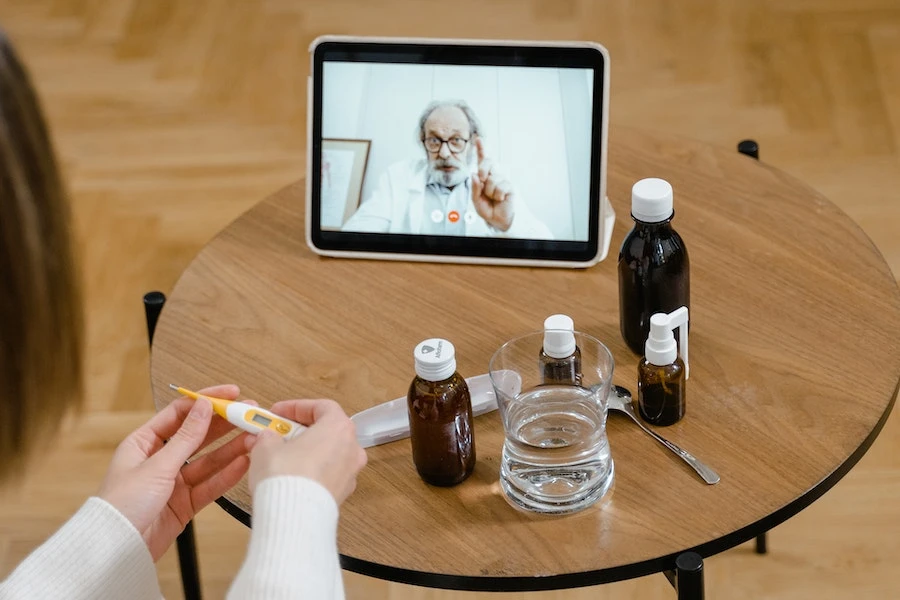
The recent Covid-19 outbreak has made it obvious that the healthcare industry must adapt faster to new challenges. All of a sudden, close contact with patients and, in some cases, physical consultations altogether became dangerous. Doctors had to switch to a new way of working, and institutions without proper tools struggled to catch up.
Medical video conferencing, although existed for years already, was the perfect invention for solving the issues raised by Covid-19. But the changes it brought to the healthcare field are more far-reaching than dealing with pandemics. The way we practice healthcare is about to change.
What Is Medical Video Conferencing?
Simply put, video conferencing is a live video connection between two or more remote parties over the internet. Such communication aims to simulate a real-life meeting as closely as possible, which is only possible when you can see the faces of all participants.
Most of us are used to video calls with friends, family, or coworkers. But medical video conferencing differs in its application, and certain quality standards must be fulfilled.
- Confidentiality is crucial when discussing health, so video software must match the highest safety standards.
- Ease of use should empower anyone, no matter the age or education, to join a video call with his doctor.
There are well-designed video conferencing solutions that can meet these criteria, and they are changing the healthcare industry.
Lowering The Costs
According to the Canadian Institute for Health Information, hospitals account for almost a third of healthcare expenses. The real number is possibly even higher as heating, cleaning, maintenance, and infrastructure costs are barely included. Medical video conferencing is a way to cut these costs without a loss in the quality of patient care.
The money saved is better spent on salaries, research, drugs, and many other urgent matters. Live video software itself does not require a lot of investment. It can be integrated into most websites, and training medical personnel to use it is not an issue as most of them are used to video calls already.
Increasing The Quality
In some cases, the relationship with patients can be improved with one-to-one video calls, as many people are expecting to have such a possibility. An increasing number of patients want to avoid the inconvenience of traveling to a healthcare institution and would rather consult with a doctor at home.
The doctor can meet the patient in his own environment, have more time to study his health history, prepare prescriptions, and see his living conditions without intruding on privacy. It ensures better doctor-patient confidentiality as a person with a visible condition doesn’t need to physically interact with staff other than his doctor.
Saving Time
Scheduling an appointment can be challenging both for the patient and the doctor. But, most medical visits do not require a physical examination. Common diseases, such as the flu, can be diagnosed remotely, which saves everyone’s time, and, if done properly, can be as effective as a live meeting.
Of course, physical consultations are unavoidable when treating more severe health conditions, but they also require ongoing patient monitoring solutions. Medical video conferencing is one of the most important ones. Simply talking with a patient about his condition on a regular basis can help prevent time-consuming procedures later.
Human Connection
The treatment of a patient doesn’t end with a visit to a doctor or drug prescriptions. Some illnesses are created by lifestyle choices. So those patients require continuous care and guidance. The physician must be available for the patient, and emails or calls are not enough to influence a positive change.
A live video call with a patient is the most convenient solution for all parties. The patient doesn’t have to leave his house, which is a problem for persons with reduced mobility, and the doctor can fit more consultations into his schedule.
Mental Health Counseling
New technologies have increased the availability of mental health resources to those in need. There are plenty of online articles, tests, and even apps for self-improvement on this topic. While this is a welcome development, face-to-face interaction with a professional is still crucial as, in some cases, self-therapy can do more harm than good.
Medical video conferencing is a great way to reach patients that would otherwise avoid meeting with social workers and psychologists. But online consulting is already a widely accepted practice in this field. A study from the American Psychiatric Association showed that six out of ten people would use online mental health care services.
Increasing Productivity
Improving staff productivity is a goal for many industries, healthcare included. While there are many ways to tackle underperformance, one of the most important is to increase the time doctors spend with patients. Medical video conferencing can help to schedule individual consultations and connect with multiple patients at a time.
Internal communication can also become more effective with live video. Gathering staff for meetings can be time-consuming as it requires employees to travel between different facilities. Setting up the software for internal meetings is easy and allows doctors to get back to their patients almost immediately.
Medical Training
Treating patients requires a great deal of knowledge, and there is no room for mistakes when it comes to human lives. Naturally, medical training is a big part of any healthcare institution. But attending such conferences and lectures in person is difficult and can demotivate those who want to learn.
The learning process must be easy for both the staff and guest speakers. Otherwise, it can damage motivation and distract from working with patients. Organizing video conferences allow healthcare institutions to collaborate with other specialists easily. Sharing knowledge and promoting research has never before been easier.
Conclusion
It is clear that medical video conferencing is greatly benefiting the healthcare industry, and the change is here to stay. The institutions that adapt to the demands of the digital age will have a competitive edge over those who miss out on the opportunities live video can bring to healthcare.


